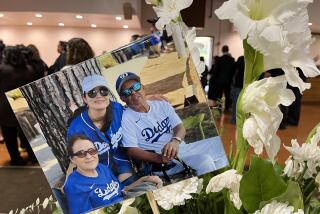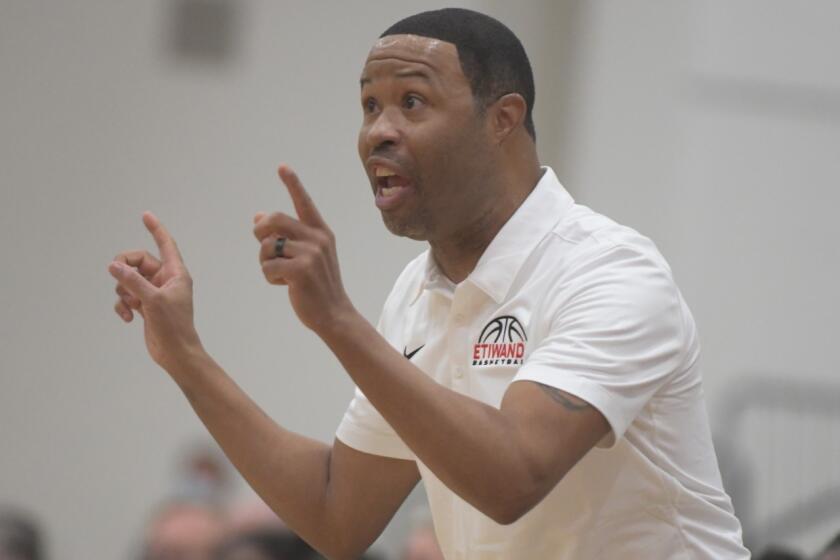The view from the stands
- Share via
I am a baseball fan. I’m 84 years old. I have been watching major league games since I was 4. I do not know whether this makes me dean of the school of fanhood, but surely I am an elder on the faculty. Most of the fires of my life have been banked. One passion remains hot and full. My passion to attend ballgames. It is an urge not to be denied.
More than half a century ago, on the evening of Sept. 28, 1954, I felt that urge. I said to my wife, “I think I’ll go to the game tomorrow.”
“You’ll never get in,” she said.
The game tomorrow was the first game of the 1954 World Series, in New York’s Polo Grounds. I stood in line for 40 minutes, mixing it up with my fellow fans. One man had come up from North Carolina. He was a cousin of former big league pitcher Max Lanier. I was a fan of Lanier, the old left-hander (I’m left-handed) who once beat the Yankees in a World Series contest.
The line moved. I lost my North Carolina friend. I finally stood at the cashier’s cage, where I plunked down $2.10 for a bleacher ticket, No. 1662, and entered the Polo Grounds.
I saw the opening game of the 1954 World Series from a wooden plank in the centerfield bleachers, the New York Giants (my team) against the Cleveland Indians (my enemy).
When I subwayed home six hours later in a state of delicious languor, I decided to write about my day. The book I wrote, “A Day in the Bleachers,” does not deal just with the game. Oh, it does that too -- the famous catch by Willie Mays takes up nine pages -- but mainly it is about my day. I banter with a Brooklyn Dodger fan nearby (she carried a flag proclaiming her allegiance). I mutter incantations of hope during the not-quite 10 innings of strife. I wince at Cleveland pitcher Bob Feller’s valiant attempt to get himself in shape by doing push-ups in centerfield during batting practice, his backside too high. I marvel as Alvin Dark of the Giants intercepts a ground ball with his bare hand in the eighth inning. And I recall one final picture that day, umpire Larry Napp running down the right field foul line, indicating that a ball struck by New York’s Dusty Rhodes was indeed a game-winning home run. Immediately, all I had seen began to percolate in my brain. I had a book to write.
It took me a few days more than three weeks to complete the manuscript.
I gave the work to my agent, Sterling Lord, who said he knew exactly the right editor: Hiram Hayden of Crown. “Hiram is a baseball fan. He’ll do it.”
A few days later, Hayden phoned Lord to invite us over. “I can’t do this book, “ he began. “I don’t know how to sell it.”
Baseball books before this, he explained, had been aimed at the kiddie market. This one was for adults. “Where do I sell it?” he asked.
Wiseguy that I was (and am), I volunteered: “In bookstores.”
“Yes,” he said. “I put it in with the sports books, and parents come along, looking for a book for their sons. This isn’t that book. I put in the nonfiction section, and it gets swallowed. I can’t sell your book.”
Besides, he was an Indian fan.
Lord next sent the manuscript to the publisher Thomas Y. Crowell, which bought it, , paid me a measly advance of $500 and discovered Hayden’s truth. Crowell also couldn’t sell the book -- a mere 3,000 copies over the next six years.
This was not my first book. I have written or co-written 26 books and perhaps 500 to 600 magazine articles, as well as book reviews, play reviews, newspaper and magazine columns, libretto notes for two seasons of opera and the lyrics of a song.
But it is “A Day in the Bleachers,” with its failed commercial history, that is my major moment of fame. I have received fan letters through the years from the few who read the book. My favorite American novelist, Anne Tyler, loved it. So did Larry Ritter, author of the very best baseball book ever put together, “The Glory of Their Times.” Baseball analyst Bill James named me outstanding sportswriter of the 1950s in his “Historical Baseball Abstract,” squeezing me between ugliest player (Don Mossi) and most admirable superstar (Ernie Banks). The New York Times selected “A Day in the Bleachers” as a notable book.
Nothing availed. The book languished. Finally, Crowell gave up on it, and “A Day in the Bleachers” was reprinted in 1982 by Da Capo Press. Here, it fared better, selling out two printings in four months. Apparently, adult readers were starting to read baseball books. Da Capo has kept the book in print ever since.
One reader, Mick McHugh, invited me to sign copies at his chophouse in Seattle. If you bought a book, McHugh gave you a ticket to the ballgame that night in the Kingdome. So a dozen of us trooped in for the game, where a television crew had been alerted, and I was interviewed on camera. Kids came flocking over for autographs. One yelled to another, “Who is he?” and the second said, “Who cares? He’s on television.”
Now, a new edition of “A Day in the Bleachers” is being readied by Arion Press, a publisher of deluxe editions. The run is only 400 copies, all signed by me and with illustrations by Mark Ulriksen.
Arion’s owner, Andrew Hoyem, a man who carries a fountain pen, has never before published a baseball book or, indeed, a sports book of any sort. But here I am, joining the pantheon of Arion authors, who include Albert Einstein, Herman Melville, John Milton and God. (Among other things, Arion has published a magnificent Bible.) The Arion edition of my book will sell for $500. The original Crowell hardcover edition sold for $3.
I don’t attend many ballgames anymore. I don’t much enjoy night driving. Nor do I like the price of tickets or hot dogs. Today’s game, in fact, deters me in myriad ways. I am appalled at the lineup of sluggers who raised their right hands to Congress and denied using steroids. I do not like huge scoreboards that inform too much. A baseball game is a mystery, unfolding. Let the scoreboard tell me hits, runs and errors, and the scores of out-of-town games. I’ll do the rest.
So why do I still feel the urge to go to the ballpark?
A pen pal of mine, Bill Littlefield, once wrote a novel called “Prospect,” in which the main character, a retired baseball scout, explains why he is still drawn to the game.
“It is a sustaining game,” Littlefield’s protagonist concludes.
Five words. Nobody has defined baseball and its appeal better.
It sustains me. I am held by its elegance, its perfect calculus of 90-foot base paths, its pitching distance of 60 feet, 6 inches to home plate. I still thrill when San Francisco shortstop Omar Vizquel, much too old to be doing this, floats into the air to avoid the slashing spikes of a baserunner and, from on high, flips the ball to first to complete the double play.
It is a sustaining game. The season of sustenance is upon us again, and we who are fans respond. *










